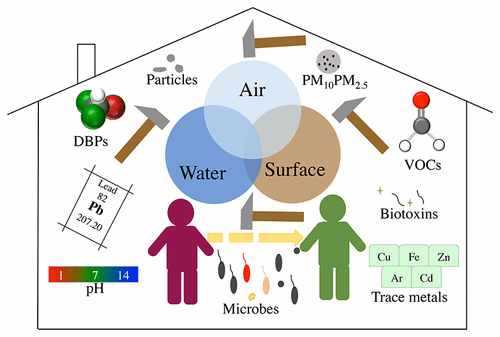Researchers at Virginia Tech’s Center for Science and Engineering of the Exposome (SEE) recently published a critical review in ES&T examining the “exposome of the built environment” and proposed engineering strategies for its control. The exposome is defined as our lifetime exposure to chemicals, microbes, and radiation and derives from anything we come into contact with, including the environment, air, water, surfaces, and food. Waterborne, airborne, and surface-borne exposomes in the built environment are highly interconnected and have important implications for public health. For example, Legionella has a propensity to grow under certain conditions in building plumbing, but cannot actually infect humans and cause Legionnaires’ Disease unless it is released into the air at an effective dose and within an aerosol amenable to inhalation into the lungs. Aerosolization itself is affected by fundamental aspects of building plumbing design, such as the type of showerhead (mist, rainfall simulation, water-conserving, etc.). This opens the door to incorporation of exposome concepts into basic features of building design.
As emphasized in the critical review, it is important to recognize that chemical-biological interactions have important implications and thus looking at either one in isolation may misrepresent the system as a whole. For example, different materials used for water delivery (e.g., metallic, plastic, or concrete) will leach different substances (e.g., metal ions or organic carbon) having varying interactions with disinfecting agents (e.g., chlorine, disinfection by-products), which can ultimately result in a net benefit or detriment for microorganism control and human health.
What is most exciting is the potential to intentionally engineer the exposome of the built environment. Some promising interventions identified in the article are relatively simple, such as adjusting relative humidity to prevent virus transmission or installing point-of-use water filters. However, fundamental research is needed to inform effective interventions that truly save water and energy, while promoting protection of public health. Most critical will be to define what a “healthy” exposome is? This is a highly interdisciplinary problem which will require biologists, chemists, engineers, building scientists, architects, social scientists, and policy makers, among many other fields working together. Addressing the following key knowledge gaps will help make the potential of “engineering the exposome” a reality:
- Evaluating the relationships between the exposome and human health outcomes.
- Building an integrated understanding of the effect of built environment design, especially those intended to improve water and energy conservation, on the exposome.
- Developing novel sensor platforms to increase the speed and ease of detecting microbes and chemicals of interest, while decreasing costs.
- Incorporating citizen-scientists as central players, enhancing value of the research by expanding access to richer sample sets while also building trust and partnership with the public in advancing an area of research that affects their everyday well-being.
Given that we spend greater than 90% of our time in the built environment, this seems an investment worth making.
You can learn more about our Science and Engineering of the Exposome (SEE) center at Virginia Tech ICTAS here, where we are striving to establish the capability to engineer the exposome of the built environment.
*This is co-authored by Aaron J. Prussin II and Amy J. Pruden at Virginia Tech.
